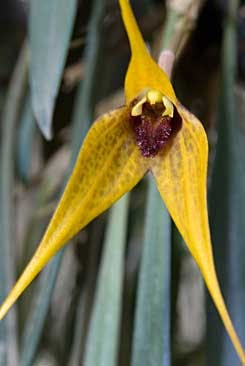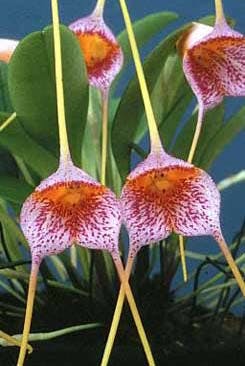Marguerite Webb discusses small-growing orchids prized for their fragrant flowers.

Masdevallia mejiana from northern Colombia. Grown by Everglades Orchids. Photo © Greg Allikas
The orchid family is famous for its exotically scented flowers. Some genera have a greater number of fragrant members than others, but it is said that nearly 75 percent of all orchid species have a fragrance. Although this percentage is not as high in the Pleurothallid subtribe, they make substantial contribution to the ranks of aromatic orchids. They may not compete with the garish, highly perfumed cattleya group, but just as the flowers of a pleurothallis or masdevallia possess a delicate beauty, their fragrance also may be subtle. Scents may be floral and sweet, spicy, fruity or foul. The variety is much of the fun.
Pleurothallis pterophora has been called the lily of the valley orchid because its numerous spikes of white bell-like flowers and sweet scent are reminiscent of that plant. The strong floral bouquet of this pretty pleurothallis is easily detected when the plant is in full flower. Because of its diminutive size and easy culture, P. pterophora is a good choice for windowsill or under lights. It grows quickly to specimen size and will reward the grower with hundreds of sweetly scented sparkling white flowers. Pleurothallis racemiflora(syn.quadrifida) is also known for its delicious aroma. This Central American species with leathery, 8-inch, paddle-shaped leaves will bloom twice a year with sprays of translucent yellow flowers. The scent is sweet and balmy.
The aroma of Pleurothallis sclerophylla is suggestive of freshly mown hay. Clouds of white spidery flowers make aterrific display on this 8-inch, narrow-leaved plant. Pleurothallis wagneri,a tiny maroon-flowered species, has an unusual licorice scent.
The genusTrichosalpinx,whose plants are characterized by stems with lepanthiform sheaths, often have white or yellow flowers with a pleasing scent. Trichosalpinx robledorum from Ecuador is notably fragrant. The white starry blossoms emit a pleasing citron aroma, which is linked, as are all orchid fragrances, to the attraction of a particular pollinator.
Many masdevallias are scented, and a few have a strong fragrance that will fill the surroundings with perfume. The most outstanding is Masdevallia glandulosa, a Peruvian species with copious lavender bell-like flowers. The luscious scent is spicy sweet and will turn the head of anyone nearby. The interior of the flower is coated with purple globules or glands. A hybrid combining Masd. glandulosa with Masdevallia strobelii, a fresh-scented species, has created another enchantingly aromatic masdevallia. Masdevallia Confetti, with its ambrosial yellow, white and lavender flowers, is a wonderfully fragrant free-flowering miniature. All three of these masdevallias grow well in intermediate conditions and do not mind the summer heat, tolerating day temperatures up to 85º F.

The cool-growing Masdevallia datura from Bolivia. Grown by Golden Gate Orchids. Photo © Greg Allikas
Masdevallia estradae, Masdevallia ludibunda and Masdevallia cyclotega are taxonomically classified in the subsection Caudatae and they possess a similar sweet scent. Of the three, Masd. estradae is the most easily obtained. Originating in Colombia, Masd. estradae and Masd. ludibunda are compact plants that thrive in intermediate to cool conditions. Their lavender and white flowers are most intensely fragrant when the sun is shining. Masdevallia cyclotega is a high-elevation Peruvian species with tall-stemmed pink flowers. Cool-house conditions (winter minimum of 52º F and summer maximum of 78º F) are essential for this masdevallia. Many of the white-flowered masdevallias are delightfully scented. Powdery and seductive, Masdevallia datura blooms with huge white trumpets reminiscent of the datura plant. Several attractive hybrids have been made with this Bolivian cool grower. Sometimes, the offspring inherit the wonderful aroma of Masd. datura. The pretty white-and-yellow flowers of Masdevallia mejiana emit a sweet scent that has peppery undertones. Give this masdevallia intermediate temperatures and it will produce flowers frequently during the winter months. The blossoms will last for several weeks. Masdevallia agaster displays its white and yellow flowers around the base of the plant. Each bloom is filled with sparkling hairs that emanate a clean, fresh aroma.
A Central American intermediate grower, Masdevallia nicaraguae has waxy, pink-flushed, white flowers that smell like soap. Masdevallia garciae, from Venezuela, has similarly scented copper-colored blossoms that are striped with dark red. Both of these masdevallias are profuse bloomers and are heat-tolerant.

Masdevallia velifera. Grown by Colomborquideas. Photo © Greg Allikas
Masdevallia corniculata may attract fruit flies with the ripe fruit aroma of the flowers. The 10-inch-tall plant produces waxy orange flowers on racemes to midway up the leathery leaf. The exterior of the bloom is glossy, while the interior has a granular texture, another indicator that the species has evolved to attract tiny flies. Masdevallia angulata also has a fruity bouquet. The large succulent flowers are held on short horizontal stems encircling the 8-inch-tall plant with blooms. These stately dark pink flowers emit the distinctive smell of grape soda.
Although the aromas of Masd. corniculata and Masd. angulata are pleasing, some fly-pollinated species have an odor that is far from agreeable. Species in the subsection Coriaceae are notoriously foul. Flowers of Masdevallia colossus, Masdevallia velifera, Masdevallia civilis, Masdevallia cacodes and Masdevallia foetens release pungent scents that have been likened to those of strong cheese, dirty socks, putrid food and a variety of barnyard odors. Some have even caused an unsuspecting orchidist to perform a shoe check when near one of those malodorous masdevallias. Flowers in this odoriferous group tend to have muted colors, often with warts, bumps or hairs near the center of the flower to lure the pollinator visually.

Masdevallia cyclotega 'J&L' CHM/AOS. Grown by J & L Orchids. photo © C. M. Fitch
Masdevallia caesia is one of the prettiest members of the Coriaceae subsection with its 12-inch, blue-green pendent leaves. The large yellow flowers have a dark red lip and their piquant aroma is only apparent at certain times. The pendent habit necessitates growing the plant in a hanging basket or mounting it on a piece of tree fern or a cork slab (with a pad of sphagnum moss or osmunda at the roots) with the elegant foliage making a lovely display. Grow this plant in intermediate to cool temperatures and provide lots of humidity.
The diversity within the Pleurothallid subtribe is fascinating and it is echoed in the variety of fragrances these plants possess. Of all their charismatic qualities their aroma is probably the least familiar, and possibly the most surprising. Discovering and enjoying the many pleurothallid perfumes is just another fascinating aspect to growing these orchids.
Marguerite Webb has been a frequent contributor to Orchids. She is co-owner of J & L Orchids with Lucinda Winn and Cordelia Head. 20 Sherwood Road, Easton, Connecticut 06612.






